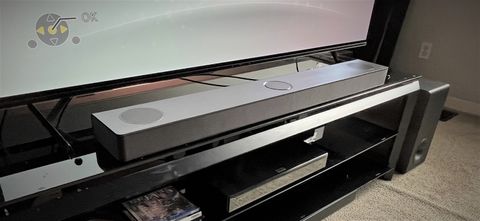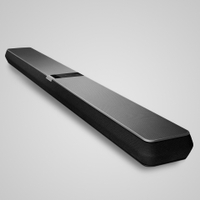TechRadar Verdict
At first glance, LG’s S80QY doesn’t appear to offer anything in terms of features or specs that would make it stand out from the competition. But its up-firing center speaker – a unique feature – turns out to be a solid innovation, and one that does differentiate it from other soundbar systems.
Pros
- +
Up-firing center speaker enhances voice clarity
- +
Dolby Atmos and DTS:X processing
- +
Front-panel LED info display
Cons
- -
Unremarkable performance with music
- -
Somewhat bulky soundbar design
- -
Subwoofer looks like a desktop PC
Why you can trust TechRadar
LG S80QY: One-minute review
LG’s S80QY is a conventional soundbar system with a unique feature: an additional up-firing center-channel speaker that helps make voices sound clearer and more naturally positioned.
While that might not sound especially impressive on paper, it goes far to improve on not just the built-in sound provided by your TV, but on many competing soundbars as well. Dialogue clarity is the main reason why most people buy soundbars, and the S80QY delivers brilliantly on that key parameter.
Beyond that, the S80QY is a 3.1.3-channel Dolby Atmos soundbar system with a separate wireless subwoofer to deliver bass, and also features processing for DTS:X soundtracks. Its performance with movies and TV shows is very good, letting it compete well with the best Dolby Atmos soundbars in its price range.
The S80QY’s feature set is solid for the price. Along with Bluetooth wireless streaming, you get Chromecast built-in and AirPlay 2 support for casting audio from a phone or tablet. Its wired connection options are also more than satisfactory and include regular HDMI and HDMI eARC ports with 4K and Dolby Vision passthrough, along with VRR and ALLM support for gaming, which is better than most of the best soundbars offer. An optical digital audio input is also supplied for connecting to older TVs.
There’s plenty of competition for the S80QY in its price range, including the Sonos Arc. But while that Sonos flagship is a model that rarely sees a price discount, you can regularly find this mid-range LG soundbar for considerably less than its initial cost. Given the S80QY's potent combination of performance and features, it’s well worth seeking out.
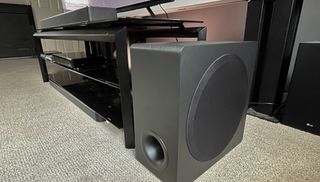
LG S80QY review: Price and release date
- Released in April 2022
- $899 / £749 / AU$999
LG’s S80QY was released in April 2022 for $899 / £749 / AU$999, though its street price has since dipped well below that amount.
At its original price, the S80QY sits near the high-end of the soundbar market, though it falls more or less squarely in the middle of LG’s full soundbar lineup. A direct competitor would be the Sonos Arc, an all-in-one solution that adds angled drivers to deliver virtual surround sound, but lacks the S80QY’s wireless subwoofer.
Another same-priced competitor would be the Samsung HW-S800B, a considerably slimmer soundbar and subwoofer package with a 3.1.2 Dolby Atmos speaker configuration. So the S80QY is right in line with the competition.
LG S80QY review: features
- 3.1.3-channel Dolby Atmos and DTS:X sound
- HDMI eARC with 4K and Dolby Vision pass-through
- Chromecast built-in and AirPlay 2 wireless streaming
LG’s soundbar is a 3.1.3 model that supports both the Dolby Atmos and DTS:X soundtrack formats. It’s also IMAX Enhanced, though the benefits of that feature are unclear save for the IMAX requirement for DTS:X processing to be onboard. A total of 480 watts of amplifier power are on tap for its nine total speakers, with 220 watts dedicated to the subwoofer alone.
Along with its front-facing speakers (for left, right, and center channels), subwoofer, and two up-firing drivers for Atmos overhead effects, the S80QY uniquely features a third up-firing driver that’s used for dialogue delivery. As we’ll discuss in the Sound Quality section, this works very well to both enhance dialogue clarity and to “lift” voices to screen level where they will sound more natural.
Both HDMI eARC and regular HDMI ports are provided and these support pass-through of Dolby Vision high dynamic range, VRR (Variable Refresh Rate), and ALLM (Auto Low Latency Mode). There’s also an optical digital input for connecting the audio output of an older TV that lacks HDMI eARC or ARC.
Along with Bluetooth 5.0 wireless, the S80QY supports audio streaming using Chromecast built-in and AirPlay 2. Another wireless connection option is LG’s Wowcast, which lets you stream audio wirelessly to the soundbar from a TV using an optional adapter that plugs into the set’s HDMI eARC output.
Built-in support for both Google and Alexa voice assistants is provided, giving you hands-free operation over basic controls, along with other smart speaker functions.
The S80QY’s sound processing modes are extensive, so you may want to visit them in LG’s SoundBar setup app and try them out before deciding which you like best. Of these, I found that Music – a mode developed with the help of high-end audio manufacturer Meridian – worked best for, you guessed it, music-listening, while Standard was a good option for everything else.
LG offers optional wireless surround speakers (the $200 SPQ8-S speaker kit) to expand the S80QY to a full 5.1.3 system. The soundbar also supports LG’s TV Sound Mode Share, a feature that lets you connect it to “the latest LG TVs to hear the full potential of your TV’s sound engine by tapping into the power of the TV processor to automatically optimize sound quality.”
- Features score: 4.5/5
LG S80QY review: sound quality
- Excellent dialogue clarity
- Powerful Atmos effects presentation
- Clean-sounding bass
Movie and TV shows sounded great on the S80QY with only minimal setup fuss. Aside from running AI Room Calibration Pro, I simply selected the Standard processing mode and let things rip.
Integration between the soundbar and subwoofer was smooth, allowing for deeper voices to come across as full and natural when both watching movies and listening to music. Bass coming from the S80QY’s subwoofer was tight and punchy. It did lack the low-frequency extension you’d get from a more pricey and purpose-built sub, but its output was consistently clean and added impact.
The LG’s overall performance was well demonstrated when I watched a scene from John Wick 3 that takes place in an antiques warehouse. In it, Wick is fighting off a gang of would-be assassins, and the sound of smashed glass display cases, gunshots, and fists and feet making solid connections with their targets, all had a dynamic quality.
Dolby Atmos overhead effects were also clearly in evidence with the S80QY bouncing sound off my room’s flat, 9-foot-high ceiling. They could be heard in scenes from JW3 when rain is pouring down on the city streets, but I got an even better demonstration when I watched a scene from 1917 where a rat triggers an explosion in an underground bunker. In it, as the soldiers are engulfed by falling debris, the sound literally seemed to be coming from my ceiling – a vivid and somewhat frightening effect.
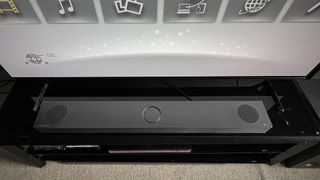
What most impressed me about the S80QY’s performance was its dialogue delivery. Voices in movie soundtracks and TV shows consistently sounded clear and natural, while the soundbar’s up-firing center speaker added a vertical dimension that “lifted” dialogue to screen level. This made it seem to be coming from actors’ mouths as opposed to a speaker located beneath the TV.
I usually don’t have high expectations for music playback on soundbars – the too-close arrangement of the individual speakers creates a “bunched-in” sound, and the processing modes used to expand it can make voices and instruments sound unnatural.
This was also true to an extent with the S80QY, though its Meridian-designed Music mode proved to be quite good for a soundbar. With it enabled, the vocals and band in Tom Petty’s “You Don’t Know How It Feels” sounded clean and unprocessed, with good impact coming from the kick drum.
If I found one notable flaw with the S80QY’s performance, it was that any sense of surround sound immersion was lacking. But that’s because the system lacks surround speakers, and you can remedy that by adding LG’s optional SPQ8-S speaker kit.

- Sound quality score: 4/5
LG S80QY review: Design
- Somewhat bulky form-factor
- Built-in power supply a plus
- Large-ish external subwoofer
The design of the S80QY doesn’t deviate much from other LG soundbars past and present. At 39.4 x 2.5 x 5.3 inches (W x H x D) it pairs well with TV screen sizes 50 inches and up, while the 5.3-inch depth means it will jut out to a degree if you opt to wall-mount it below a similarly wall-mounted TV.
Otherwise, the bar’s dark gray plastic case has a solid and streamlined look, with gently rounded edges and a matching gray fabric grille wrapping around the front and sides. The up-firing drivers are each covered by a circular metal grille that spices up the design a bit to make it appear high-tech.
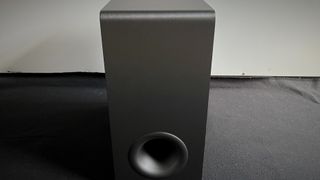
Importantly, the S80QY has a built-in power supply. For this reason, you’ll only need to plug in an AC cord for power rather than using an external power brick – something that earlier LG soundbars used. It also features a set of touch-sensitive controls on the top surface that duplicate basic remote control functions.
LG’s wireless subwoofer has almost the exact same dimensions as a desktop computer. Except for the presence of a large front-firing port, you might even mistake it for one.

- Design score: 4/5
LG S80QY review: Usability and setup
- HDMI pass-through with eARC eases setup
- Room calibration feature improves sound
- Readable front panel LED display
Setup of the S80QY is made simple by its HDMI eARC port, which is used to make a direct audio connection from your TV’s HDMI eARC or HDMI ARC output. I tapped both that and the LG’s HDMI input to connect an Ultra HD Blu-ray player, and had no problems with 4K or Dolby Vision pass-through from the soundbar to the TV.
Setup of the system’s subwoofer is a snap: just place it near the soundbar, plug in, and it automatically makes a wireless connection with the soundbar. LG boasts of the subwoofer’s extended wireless range on its website, which will allow you to set it anywhere in the room you like. However, I find that the subwoofers that come with soundbars generally work best when the two are positioned close to each other.
LG’s’ Sound Bar app provides adjustments to do everything from setting dynamic range control (for late-night viewing) and individual woofer, center, overhead, and rear (when applicable) speaker levels to running LG’s AI Room Calibration Pro. That last feature helps quite a bit to improve the system’s sound quality, primarily by tightening up the bass output, and comes highly recommended.
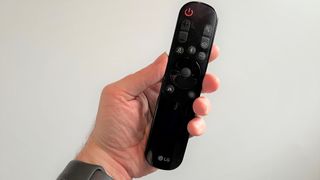
LG’s remote control is a slippery plastic thing, but it has a simple button array and will let you do most things you’d want such as adjust volume and switch inputs and sound modes. You can also use it to make basic EQ and individual speaker level adjustments. Anything more complicated than that and you’re better off firing up the app.
When using the remote, any adjustments you make are confirmed by the S80QY’s alphanumeric LED display. This indicates volume and input selection, and it’s also used to make bass and treble adjustments – something you strangely can’t do in the app. I found that a -1 treble cut worked best for the S80QY in my room, though your results may differ.
- Usability and setup score: 4/5
LG S80QY review: Value
- Average price for a Dolby Atmos soundbar
- Can regularly be found for less than list price
The S80QY’s list price puts it at the higher end of the soundbar system price range where it faces competition from the Sonos Arc and Samsung offerings like the more compact and elegant HW-S800B.
Even so, the S80QY in many ways holds its own against those other options with its powerful and dynamic sound, ample wired and wireless connections, and solid overall feature set. LG’s 3.1.3 soundbar is also regularly sold at a deep discount from its listed price, making it an even better value.
What most distinguishes the S80QY from other soundbars is its up-firing center channel speaker, which really goes far to improve dialogue clarity and the naturalness of its presentation. So if that particular feature holds appeal to you, you can add an extra star to our value rating.
- Value score: 4/5
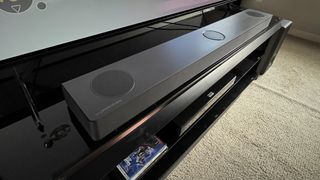
Should I buy the LG S80QY?
| Attributes | Notes | Rating |
|---|---|---|
| Features | HDMI eARC plus HDMI pass-through | 4.5/5 |
| Sound quality | Powerful Atmos effects and excellent dialogue clarity | 4/5 |
| Design | Standard design - a bit bulky compared to other systems | 4/5 |
| Usability and setup | Very easy to use and comes with an excellent setup app | 4/5 |
| Value | A good overall value for a Dolby Atmos soundbar | 4/5 |
Buy it if…
Dialogue clarity is important
One of the things that LG’s 3.1.3 soundbar does best is to reproduce voices in a clear and natural manner. In this respect, it has an edge over some competing models.
You want streaming options beyond Bluetooth
The S80QY features both Chromecast built-in and AirPlay, and both of these will let you stream uncompressed audio from your phone or tablet.
You want Atmos and DTS:X
Both Dolby Atmos and DTS:X processing are part of the S80QY’s feature set.
Don't buy it if…
You want surround speakers
The S80QY doesn’t ship with rear speakers, and you won’t experience a true sense of surround sound with it. You can buy LG’s optional rear speakers for an extra $200, however.
You want an all-in-one
LG’s soundbar is somewhat bulky. It also relies on a separate, relatively large wireless subwoofer for bass.
You don’t care about Dolby Atmos
If you’re interested in just making a basic improvement on your TV’s built-in speakers, there are plenty of cheaper soundbar options available.
Also consider
Samsung HW-S800B
This Samsung system delivers dynamic Dolby Atmos sound from an almost impossibly thin soundbar and compact subwoofer. Connection options are limited – primarily, there’s no HDMI pass-through or eARC – but its overall sound balance is impressive for the size, which is a lot less bulky than the LG.
Bowers & Wilkins Panorama 3
While the Panorama 3 is a bulky soundbar that doesn’t excel at delivering Atmos height effects, it’s adept at music playback – not surprising given the company’s heritage. So if music is important to you, this is a good all-in-one alternative to the LG.
Sonos Arc
This flagship soundbar from Sonos packs a lot of drivers into a single soundbar, letting you get both overhead Atmos effects and a semblance of surround. The main drawbacks are relatively limited bass and a relatively high cost, but its a more compact and elegant solution than LG’s soundbar.
- First reviewed: July 2022
- How we test: read TechRadar's reviews guarantee

Al Griffin has been writing about and reviewing A/V tech since the days LaserDiscs roamed the earth, and was previously the editor of Sound & Vision magazine.
When not reviewing the latest and greatest gear or watching movies at home, he can usually be found out and about on a bike.
